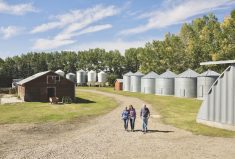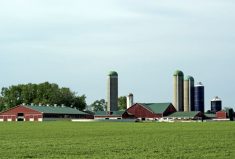The death of the family farm is widely bemoaned. Activists ask, “What do we really know about these corporations that produce our food?”
As it turns out, it’s the same question that many farmers are asking themselves, although in a very different context. How can I be sure that my farm corporation is the best design for my farm and my family? Can I really be sure its fine print isn’t hiding a time bomb that we’re going to deeply regret in future?
Canada’s 2011 Census of Agriculture clearly showed that family farm corporations are on the rise at the expense of sole proprietorships. However, the census also found that the trend is linked to gross farm receipts; the higher the receipts, the higher the rate of incorporation.
Read Also

Farmland values: assumptions and realities
Where farmland values are headed and what decisions farmers should make
Many farmers have turned their operations into corporations as the next step in a natural progression that had already seen them evolve from sole proprietorships into partnerships, says Robert Berry, partner in the Miller Thomson law firm at Guelph, Ont.
In the past 25 years too, the rate of incorporation has been hastened by taxes, Berry says. “And transfer driven… but that’s also affected by tax.”
That isn’t to say accountants and succession planners suddenly discovered corporate advantages overnight. Berry says he has been helping a steady stream of clients incorporate for the last 20 years, so it hasn’t really been tied to the boom and bust cycles that come with fluctuating commodity markets.
- More Country Guide: Are Canadian farmers ready for the succession challenge?
But there’s no question that there’s been a surge, and these complex business structures have now become commonplace enough to be almost predictable.
“Generally, we’re seeing a transfer of operating assets into corporations, but land and buildings, or at least the main residence and a garage, stay in the name of the original holders of the property,” Berry says. “Since I started 40 years ago, the main issue is still the same; giving up title to the property creates emotional issues and concerns, so they leave the farm property in the name of a parent.”
No one adopts change, especially change which causes “issues” unless there is good reason. In good years, the incorporation trend can be explained by its tax savings. As for the bad years, some speculate that farmers may be looking for a means of limiting liability. But Berry says that although one of the advantages of incorporating is often said to be limiting liability, he sees more reliance on insurance to achieve that goal.
But this brings us to the crux. From Berry’s perspective, it’s accountants who are driving the bus on the corporate trend.
Mona Brown farms and practises law in Carman, Man., and says understanding how corporate farms are run will likely become even more difficult. She’s seeing more farmers willingly adopt very complex business structures, especially young incoming farmers willing to skip sole proprietorship and partnerships entirely.
“The young generation is very, very comfortable with incorporation, with tax planning, and with paying for tax planning because it is really smart,” says Brown. “I’m not saying the older generation wasn’t, but these farmers are savvier with these mechanisms, and they read more.”
Brown says it’s exciting for her to work with such savvy newcomers who think a little more outside the box. When they come to her, she says she finds the trend is to adopt one of three popular structures.
One of the most common scenarios is to join them with an established farm corporation. Whether it is his family or hers, a family trust is a great way to allocate growth in the company to farm kids looking to take over the corporate family farm.
In most of the cases that she sees, Brown says a trust has already been established as part of the original incorporation process. When she builds such a business structure herself, she likes to create a corporate operations company (OpCo) for managing equipment, livestock, and quotas in addition to a corporate land holding company (LandCo) which is only responsible for land.
“We have them as two separate companies, with the shares all owned by the family trust,” Brown explains. “The family trust gives us the ability to get income or capital to other family members without changing the decision-making.”
In other words, those who control the trust, control the corporation, and when it’s time to pass the farm on to the next generation, parents only have to hand over their trust shares.
The next most common structure that Brown sees for passing on the family farm is to set up three companies. One corporation is established for the parents, another one for the children, and then the two corporations work together as a joint venture. “In the joint venture, they combine their equipment and labour, and gradually the parents’ company stops buying and the kids’ company keeps buying.”
Since a privately controlled Canadian Corporation (CCPC) is considered a small business as long as it generates no more than $500,000, this allows large operations to take advantage of small business rules, Brown says.
But unlike having a family trust, there are fewer succession options. “This doesn’t leave us the flexibility the first structure does for using multiple capital gains exemptions,” Brown says. “There’s more in the estate planning side if you have a family trust, but you don’t get three small-business limits.”
Finally, one of the most popular ways she structures incorporations actually reaches back to a more familiar structure in the beginning. Brown says she encourages her young clients by starting first with a spousal partnership. Not only does it act as a two-year trial period, it allows her to sell partnership interests into the corporation rather than actual assets, inventory, and equipment: “so, you get the value out of the company using your capital gains exemption.”
“It works something like two people carrying a shopping bag together,” Brown explains. If you take your grain or equipment out of that shopping bag, you can’t use the capital gains exemption. Instead a husband hands one handle of the shopping bag to the new corporation at 9. A continuation agreement between the corporation and the wife is drawn up, enabling the shopping bag to continue moving forward without the husband. At 10, the wife hands her handle of the shopping bag to the corporation, automatically dissolving the partnership. “Now they have all their assets in the corporation and the value of their handles is owed to them by the company as a shareholder loan.”
Brown says ever since 1985, when the capital gains exemption first came out, this has been a popular choice.
The ability to discuss, compare and deploy such a wide range of strategies is why Brown says she is so encouraged by the upcoming generation of farm owners. Whether they’re taking over the family business or starting out on their own, they are not leery of incorporating when it suits their operation, and they are not afraid to plan well into the future.
As far as Brown is concerned, fortune will favour those who think furthest forward. “Farmers have such ability to succession plan, they have the best rules, it’s amazing. Clients should not have to pay a bunch of capital gains tax,” Brown says. “But if they don’t plan early, they’re likely to pay more tax.”
Meanwhile, Lance Stockbrugger is one of the chartered accountants that Berry says is part of the reason for the growing number of incorporations. Stockbrugger also farms in LeRoy, Sask., and he points as well to recent farm profitability: “Now that we’re seeing more value, there are things we can do to protect that value.”
Part of that value has been realized from agricultural business activities. But not all of it. Increasing off-farm income also has significant impact on most modern farms’ money management strategies.
Corporate farms have an operational advantage in claiming only the annual earnings needed for personal living costs as income, leaving unused value for future business expenses and corporate taxation. Where off-farm income covers all personal expenses, incorporation can appear particularly attractive.
Incorporating also allows for converting taxable income into “active business income” payable to farm corporate shareholders as dividends, and enables the spread of the tax burden to spouses, parents, children over 18, or even non-farming relatives.
Information about farm corporations isn’t exactly easy to find, and at the coffee shop, direct ownership of shares forms the basis of many legendary tales of family fallout, which is why Stockbrugger always recommends a family trust be added where multiple parties are involved.
“You might not ever need a trust. A simple basic share structure might be just fine, but how do you know?” Stockbrugger asks. “The ‘simple’ corporations cost more money in the long run.”
From what he has seen, direct ownership of corporate capital works for some long-established partnerships that are quickly approaching retirement, but Stockbrugger says it’s a mistake to try to save money up front by keeping a corporation simple. A trust that has to be added to an established corporation is 10 times more expensive than paying for one to be built into a corporation at startup.
“If it’s complicated to you, it is probably a good structure,” Stockbrugger says. “The more things you can build into it now, the more it will help in the long term.”
This article first appeared as, “A trust for your corporation,” in the October 2014 issue of Country Guide
















